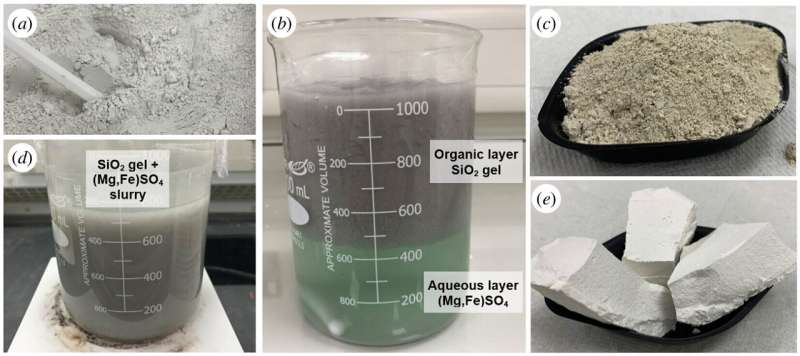
A small team of materials scientists and environmental engineers at Imperial College London has found that using olivine in cement could result in carbon-negative concrete. In their study, published in the journal Royal Society Open Science, the group conducted experiments with cement mixing that resulted in a way to produce it in a more climate-friendly manner.
Prior research has shown that cement-making is one of the major contributors to the release of CO2, and it happens in two ways. The first is when fossil fuels are used to heat products used in the mix (clay, water and calcined lime) when creating cement. The second is when limestone is heated to produce clinker, a cement binder. In this new study, the research team found a replacement for clinker that does not result in CO2 emissions.
The researchers found that adding products from olivine to cement mix instead of the clinker resulted in a cement that was not only more Earth-friendly, but also stronger and more durable. They note that olivine is an abundant mineral that contains silica and magnesium sulfate, which can be extracted and which also reacts with CO2, resulting in sequestration.
In their work, the research team extracted silica and magnesium sulfate from olivine samples by dissolving them in sulfuric acid. They then bubbled CO2 through a batch of the slurry that resulted, which in turn led to the formation of a mineral called nesquehonite during cooling and resulted in sequestration of the CO2. The nesquehonite was then added to the cement mixture, along with some amount of clinker.
The researchers note that if the process were scaled up, the CO2 used in the process could be pulled either directly from the air around the plant or by capturing the gas as it was emitted from fossil fuels as they are burned while heating the mixture. They state that depending on how much nesquehonite was added to the cement mixture, the process could be either carbon-neutral or carbon negative.
More information: Barney Shanks et al, Carbon capture and storage in low-carbon concrete using products derived from olivine, Royal Society Open Science (2024). DOI: 10.1098/rsos.231645
© 2024 Science X Network
Citation: Researchers find use of olivine in cement production could result in carbon negative concrete (2024, May 2) retrieved 2 May 2024 from https://techxplore.com/news/2024-05-olivine-cement-production-result-carbon.html
This document is subject to copyright. Apart from any fair dealing for the purpose of private study or research, no part may be reproduced without the written permission. The content is provided for information purposes only.
